
Eclipses in Timing Solution + Eclipses Finder
While working with Eclipses (Solar and Lunar) and occultations (the moments when the Sun's or the Moon's visible disk covers some other planet), we should remember always that these phenomena are observed in some specific areas of the Earth.
For example, this is how the latest Solar Eclipse (August 1, 2008) looks like (the latest - as this article is written in December 2008):

The shadow of the Moon covers North semi sphere of the Earth.
The next Solar Eclipse, January 26, 2009, will come through the oceans mostly and hit Australia only:

These trajectories are called Eclipse Paths.
The same way we can calculate Lunar Eclipse Path. See this path of the upcoming Lunar Eclipse on February 9, 2009:

The occultation is another interesting astronomical phenomenon. It occurs when the Sun or the Moon covers some other planet as observed from the Earth's surface. As with Eclipses, we can observe these phenomena from some particular places on the Earth. Thus we can calculate the occultation path. As an example, look at this Moon-Saturn occultation path that took place on September 10, 2001:

The next Moon-Saturn occultation on October 7, 2001 had hit Afghanistan.
Astronomically the occultation corresponds to the conjunction both in longitude and latitude. Usually 15 minutes orb is applied (this is the Moon's disk visible radius).
Timing Solution makes possible to use Eclipse points in your work. First of all, you need to define how the Eclipses should be calculated. In "Options" open the "Astronomy" tab; there you will find the parameters to be used to calculate Eclipse points:

Specify what Eclipses you are interested in:

It is possible to search eclipses that hit some particular place on the Earth (exchange location as an example) or you may look for any eclipse that happens anywhere (not important where).
Then choose the type of Eclipses:

If you would like to be more precise, you may define the Eclipse's strength using "Min coverage" parameter.
Now you need to indicate that you will use Eclipses in your calculations (because it takes some time to calculate Eclipse points):

When all these steps are done, you can work with Eclipses as you do with regular planets.
For example, using ULE module, you may find the moments when Mars hits Eclipses:

To designate Eclipses, I use ![]() symbol; the program will use the coordinates of the last Eclipse. Besides you can use "future
Eclipse"
symbol; the program will use the coordinates of the last Eclipse. Besides you can use "future
Eclipse" ![]() ; the coordinates
will correspond to the next Eclipse.
; the coordinates
will correspond to the next Eclipse.
For example, today is December 12, 2008. The coordinate of the last Eclipse is 10 degrees of Leo (it took place on August 1, 2008), while the next Eclipse has the coordinate as 7 degrees of Aquarius (it will be on January 26, 2009):

It is very interesting to look at the planetary lines calculated for Eclipse points:

Pay attention to the fact that Eclipses� coordinates change jumpy. Approximately once in half a year the Eclipse point changes its coordinates. Look at Eclipses and Venus ephemeris together (red - Eclipse, green - Venus):
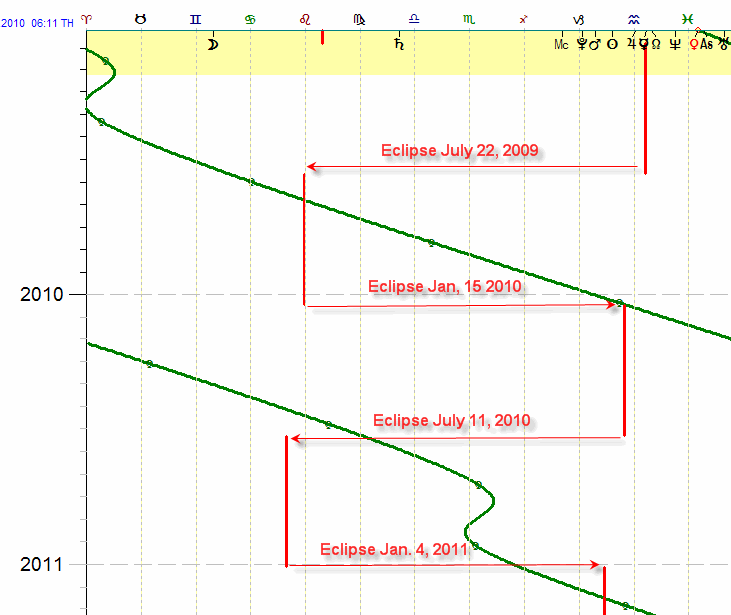
Advanced version of Timing Solution has now a special module devoted to Eclipses (Solar and Lunar) and Moon occultations.
Run it "Advanced"->"Eclipse Finder". The main feature of this module is that it allows to observe Eclipses on the price chart and on the Earth surface simultaneously.
It works this way:
1) Clicking "Calculate" button, calculate 10 Eclipses starting
from the year 2005 (the starting year and the amount of Eclipses can be defined manually);
2) After the calculation you will get a list of Eclipses with dates and their
qualities. Highlight any of them, and
3) the program will show you the Eclipse path for the chosen record:

At the same time the program marks the date that corresponds to this chosen Eclipse using vertical stripe on the price Chart:
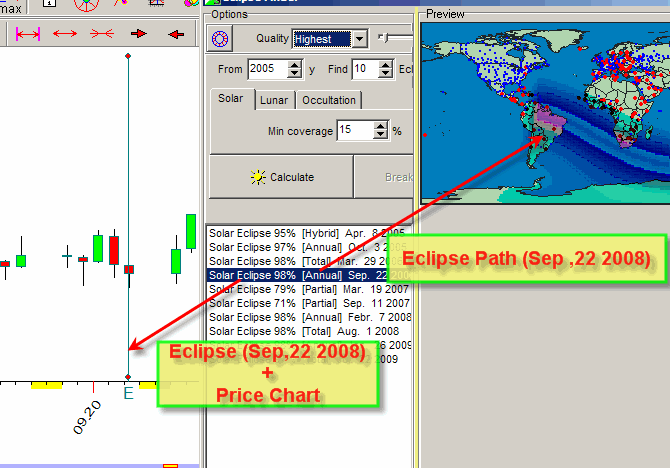
Thus you can see the territories covered by Eclipses and the price chart for these moments.
You can calculate Solar and Lunar Eclipses and Moon - planets occultations:

Here you can change the transparency of the Eclipse module and quality/resolution of the Eclipse chart:

For the fast preview of analyzed paths you can use "Draft" quality, the calculations will be conducted faster. Varying transparency you can see the price chart behind the Eclipse module.
Clicking this button ![]() you create a stand alone window with chosen phenomena,
you create a stand alone window with chosen phenomena,
Moon-Neptune occultation cycle
Pay attention to the Moon-Neptune occultation cycle. This phenomenon takes place lasts for 1-2 years, and these periods take place once in 7-10 years - as in the picture below (red stripes represent the periods when Moon-Neptune occultation takes place):
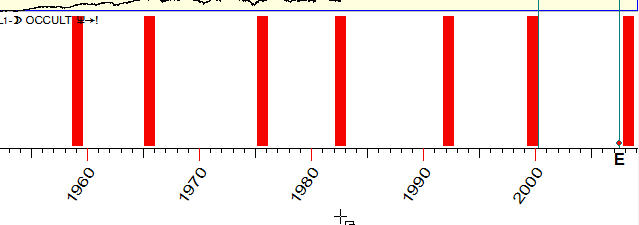
I recommend to pay attention to this cycle because 7-10 years cycle is close to Juglar economical cycle which is very influential for different economical data.
Now (December 2008) we have just passed this period. It started on July 3, 2007 and covered isolated Antarctic territories. Less than two weeks after it an epopee of Financial Crisis 2007-2008 started:
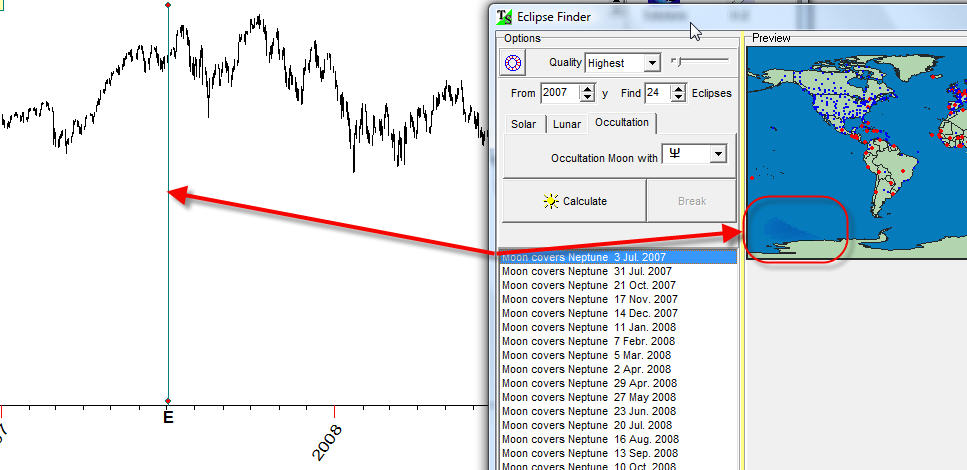
It looks like it has affected not only Antarctic penguins. Since the first appearance, this phenomenon took place every month, and every time it has covered some territories not very important economically in a global sense. Then Australia was involved, and South Africa followed - until May 27, 2008. At that day the Moon - Neptune occultation path covered this:
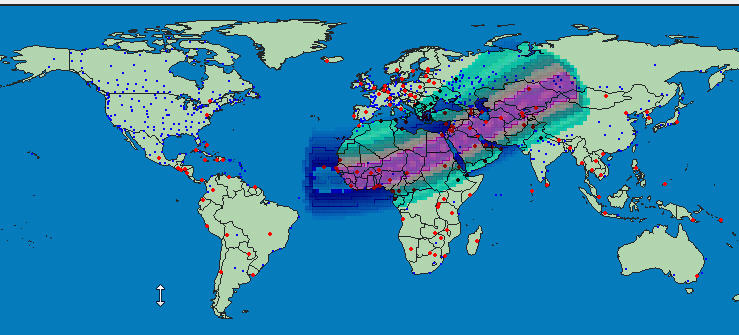
This is how stock market reacted to it:
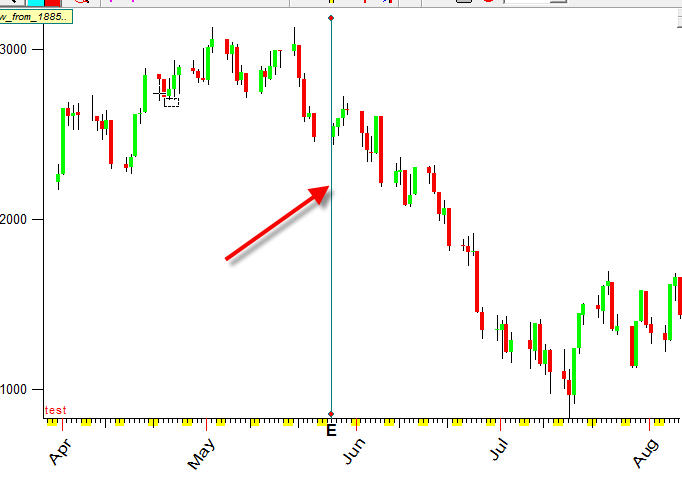
In a month, on June 23, 2008, the shadow of the Moon in the light of Neptune hit America first time. It was very strong occultation path, and reaction of stock market (delayed on three days) has been strong as well:
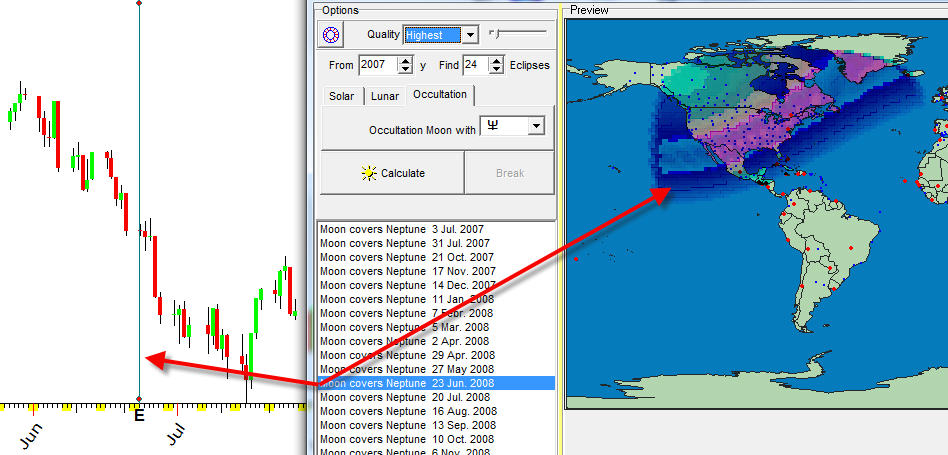
The last occultations (September 13, October 10 and November 6) has shown the dramatic effect on the stock market as well.
Look at the occultation on September 13, 2008. There is a connection to Icelandic financial crisis (September 29, 2008 - the nationalization of Glitnir bank occurred). This is a path of this occultation:

The last Moon-Neptune occultation in this series (November 6, 2008) came through Iceland once again:
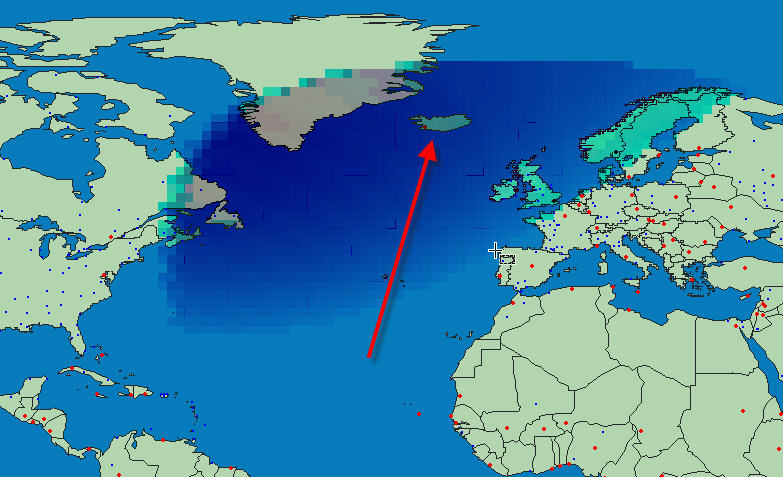
I hope it is enough.
The previous series of Moon-Neptune occultations put the end of another bubble - dot-com era:
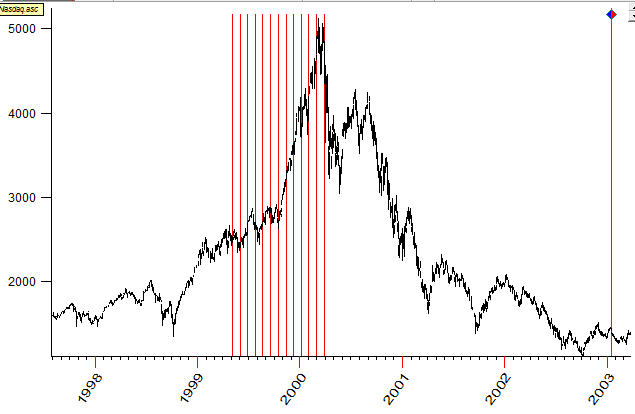
I think it would happen earlier, but the "problem of 2000" prolonged this story.
We could call this Moon-Neptune occultation cycle as bubble melt-down cycle - remembering that Jung compared the Neptune's impact to some universal dissolvent.